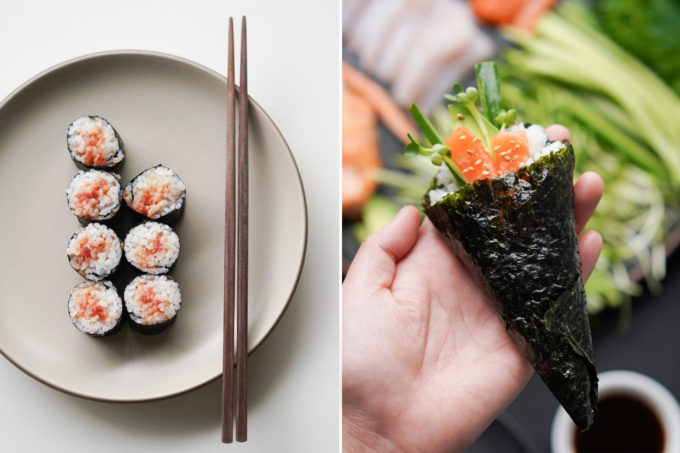
Sushi is one of Japan’s most popular dishes and is basically seasoned short-grain rice paired with a combination of seafood (most often raw) and sometimes herbs or vegetables. Surprisingly, sushi originated from ancient China during the 4th century where they placed salted fish in cooked rice.
The end result was fermented rice and preserved fish. It spread to Japan alongside Buddhism in the 9th century and the term sushi translates to “sour” or “sour-tasting” in Japanese. The first type of sushi made was called nare-zushi, or “aged-sushi.”
Some of Japan’s most traditional sushi comes in varieties like maki rolls and temaki. The main difference between these two types of sushi is that maki rolls are rolls that are cut into bite-size pieces and temaki are hand rolls kept in a cone or log shape that’s meant to be bitten into.
If you’ve ever had the chance to eat at a sushi restaurant you may have eaten these types of sushi before. Some of my favorite local spots are Ootoro Sushi, KazuNori, and Hama Sushi, but you can also buy premade sushi at grocery stores like Mitsuwa.
Cut sushi rolls / maki
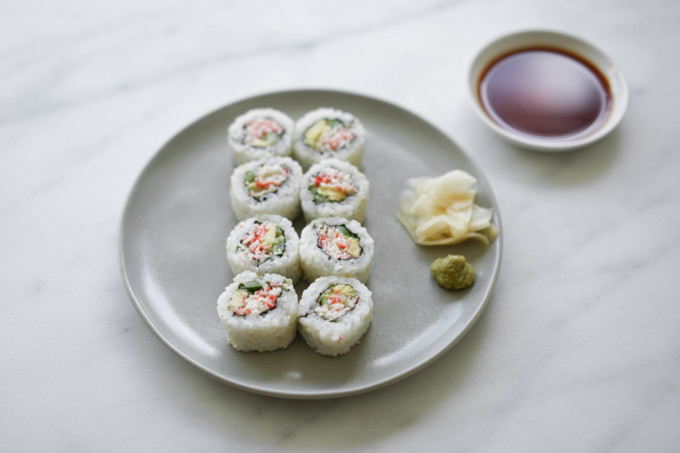
Cut sushi rolls are some of the most well-known versions of sushi. I would say that the most popular sushi roll is either spicy tuna or California roll–seeing as these two are a staple in many Japanese restaurants. There are many names for cut rolls: makimono means “variety of rolls, makizushi (or maki for short) means “rolled sushi,” and norimaki means “nori roll.”
Makizushi is made by using a makisu (or bamboo mat) and layering a piece of nori (roasted seaweed) with seasoned sushi rice and then adding fresh fish and/or vegetables on top. Then, using the makisu to roll up the nori and fillings into a log and cut it into bite-sized pieces. This is also similar to kimbap (Korean sushi rolls).
Makizushi are cylindrical in shape and can come in two types depending on how many fillings they each have:
- hosomaki rolls have one ingredient and they are thin (about 1 inch thick)
- futomaki rolls have two or more ingredients and are thicker (about 2 or more inches)
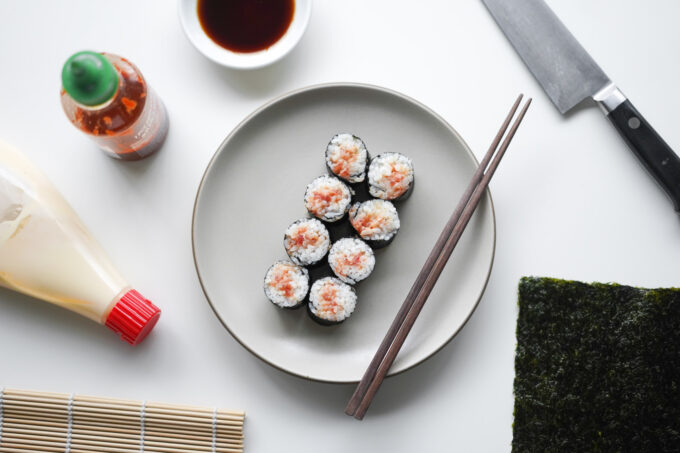
When you go to a sushi or Japanese restaurant, they typically have different varieties of maki rolls available. From my experience, they are often split into two sections: classic (or regular) rolls and specialty rolls. Typically these specialty rolls cater to the more American style of sushi–there are a lot more toppings and sauces, cooked fillings like lobster, and western ingredients like jalapenos.
I would like to note that there are sushi restaurants that focus on a traditional type of sushi experience where they do not serve sauced-up specialty rolls. These restaurants, like Hama Sushi, like to focus on the flavor of the fresh fish and seasoned rice. While they do serve maki rolls, these rolls are typically more simple, like spicy tuna or cucumber rolls. Usually, these restaurants will have notices at the front that specifically state they do not serve tempura or specialty rolls.
Here are some examples of classic rolls are:
- spicy tuna roll
- California roll
- cucumber roll
- salmon and avocado roll
- rainbow roll (a California roll with various types of fish and avocado on top)
Some specialty rolls that I have seen in restaurants typically have more fillings and toppings like dynamite and eel sauce. Here are some examples:
- Sake bomb: spicy tuna, cucumber, and shrimp roll topped with salmon and avocado and drizzled with imari and hot sauce
- TJ roll: shrimp and vegetables roll with tomato, jalapeno, and garlic chips on top
- Philadelphia roll: salmon, avocado, and cream cheese
For a more in-depth comparison of the types of hand rolls and cut rolls, check out my step by step guide for rolling sushi four different ways.
Hand rolls / temaki
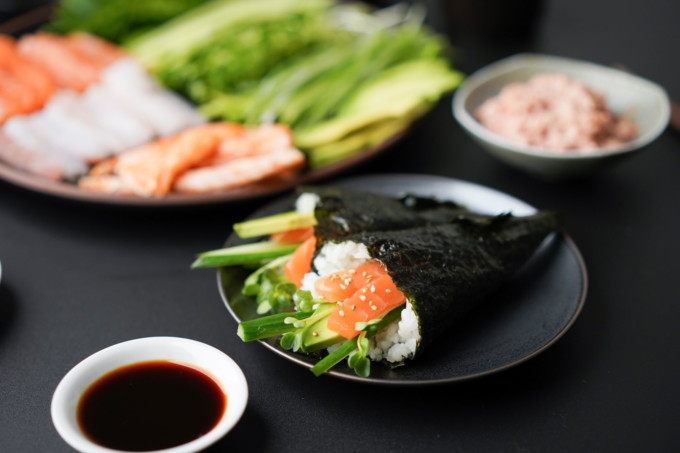
Hand rolls are another type of sushi and differ from makizushi because they are left whole and are not cut into bite-size pieces. This type of sushi is also called temaki, or quite literally “hand roll.”
Temaki is basically a bed of seasoned sushi rice layered with different ingredients of fish, greens, and vegetables wrapped in a crisp sheet of nori. It’s shaped like a cone (like Temakira) or a long cylinder (like KazuNori) and usually is about 4 inches long.
True to its name, you make temaki using your hands (instead of a sushi mat like makizushi) and you eat this sushi with your hands because its long shape makes it difficult to eat with chopsticks. You also want to eat temaki immediately after assembling in order to enjoy the crisp, roasted nori.
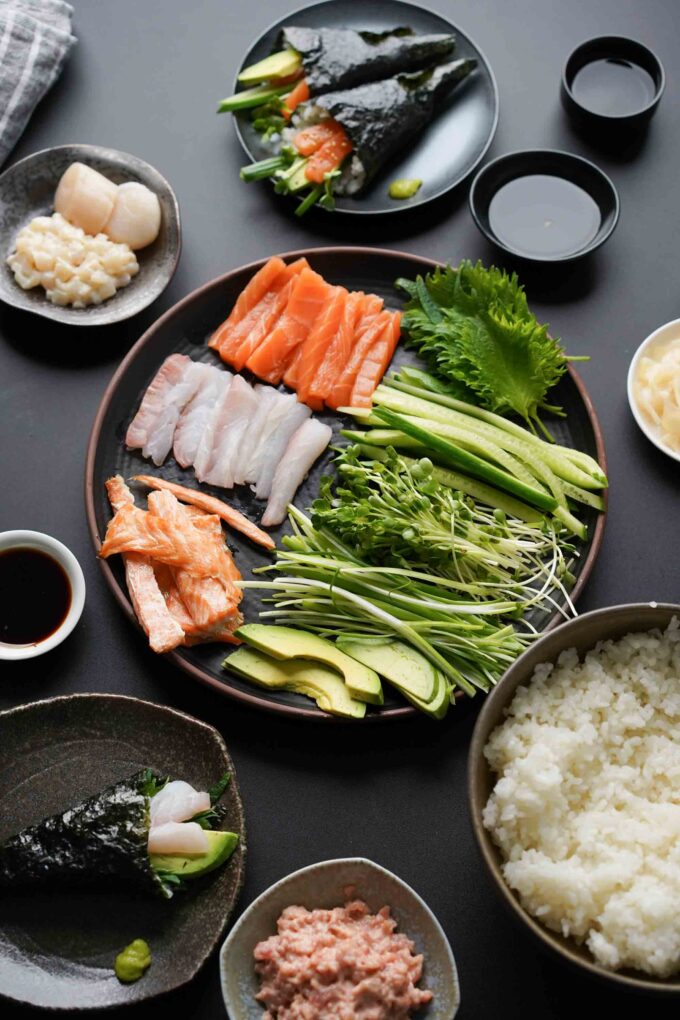
I would say it’s less popular than makizushi, but thanks to restaurants like KazuNori or Temakira these hand rolls are a growing trend. Recently, I have even seen Mitsuwa sell spicy tuna temaki with a protective sheet over the nori to keep it as crisp and fresh and possible.
One of my favorite sushi to make at home when I have an untamed craving is temaki because it’s super fast to prep and eat! Making temaki, or handrolls, can also be a fun DIY handroll dinner for you and your friends and family. All you have to do is prep some sushi rice, slice or mince some fresh sushi-grade fish, and add on any accouterments like cucumbers or scallions.
Some of the most popular fillings and varieties of temaki are:
- baked salmon skin with radish sprouts and cucumber slices
- spicy tuna with radish sprouts
- salmon avocado with sesame seeds and scallion strips
- sed snapper with shiso leaves
- blue crab mixed with a little Kewpie Japanese mayonnaise









